
[Source:
Paul Wright & Alan Young]
old21.jpg)
Bacup engine shed in the early part of the 20th century when it was still operated by the LYR. The shed was adjacent to the Rochdale line south of the station.
Photo from Roger Griffiths collection 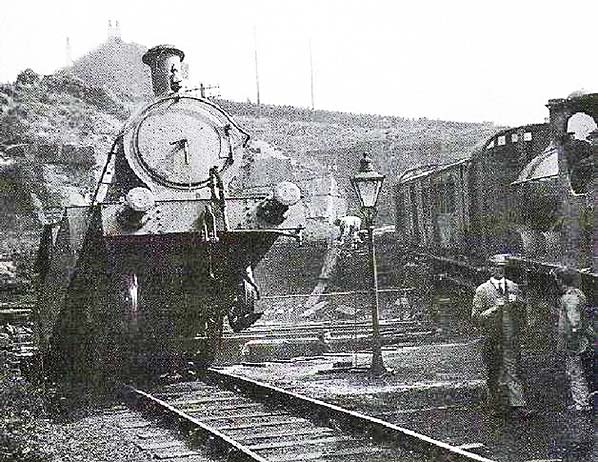
A mishap at the turntable at Bacup shed in September 1930. A 2-4-2 tank has run too far and tumbled into the turntable well. Coming to its aid is an ex-LYR 0-6-0 drawing a tool van alongside it in preparation for lifting the loco out of the pit. Bacup, or Newline, Tunnel is in the background. The view is looking south-east.
Photo by W A Camwell, courtesy of Whitworth Historical Society and from Roger Griffiths collection old22.jpg)
The date of this photo of Bacup engine shed is possibly June 1947 as this photographer took photographs at Healey Dell and Britannia in this month when passenger services on the Facit Branch were suspended, never to be restored. The locos are at the west end of the shed, where it appears that out-of-use engines were kept. If it were at the east end, smoke might be expected to be coming from some of them, and maybe the odd Stanier 2-6-2 tank would be seen (since Bacup had six of them). The locos in shot are, starting at bottom left, an LYR Aspinall 0-6-0, with two LYR Aspinall 2-4-2 ‘Radial’ tanks on the same road. The next road has another LYR Aspinall 0-6-0 facing the camera. The right hand road is host to an LYR Hughes large-boilered 0-8-0.
Photo by W A Camwell, courtesy of Whitworth Historical Society and from Roger Griffiths collection 
A Rochdale-bound train is leaving Bacup, probably in the mid to late 1930s, although the filthy condition of the loco, making the number unidentifiable, suggests that the photo might date from very early in World War 2: 1941 at the latest, for the reason stated below. The view is looking north-eastwards. In the background, with the eye of faith, the junction with the line to Rawtenstall and Bury can be seen and, at the base of the chimney, the splitting signal is for the two platforms in Bacup station. The locomotive is one of ten Lancashire & Yorkshire-designed Hughes 4-6-4 ‘Baltic’ tanks built very early in the LMS era at Horwich (1924). It is almost certainly shedded at Agecroft; this shed had regular passenger turns to Bacup, sometimes working outwards via Bury and returning via Rochdale. All of these locos were withdrawn between 1938 and 1941. The loco is working bunker-first to Rochdale, which is unusual for the route. Smaller tank engines usually ran bunker-first to Bacup to avoid possible problems with exposing the firebox crown as they approached Britannia summit when the water level was running low. The first carriage is a standard 9-compartment LMS suburban vehicle of 1930s vintage, and the second appears to be an LYR brake carriage.
Photo
from of Whitworth Historical Society
old8.jpg) Bacup Station entrance on Rockcliffe Road looking west in the 1950s. The main station building which gave access to the island platform is clearly shown.
photo from John Mann collection 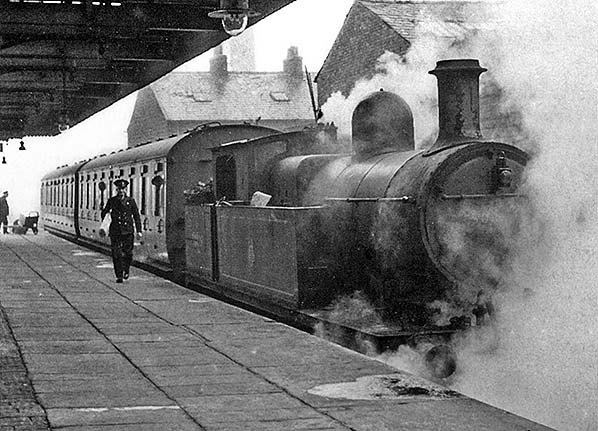 In the early 1950s an ex-LYR 2-4-2 radial tank is standing at Bacup station at
the head of a 2-coach train. Photo by David Lawrence 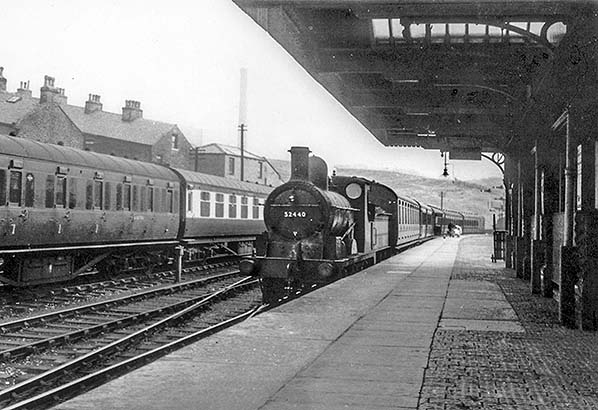
Bacup station, looking south along the east face of the island platform c1952. Behind the photographer would have been the exit via the booking office to the street. At this time Bacup was a busy station as evidenced by the spare coaches in the sidings on the left of the picture although only the Irwell Valley route from Bury to Bacup was now open for passenger traffic. The locomotive No.52440 is Aspinall-designed Lancashire & Yorkshire Railway Class 27 0-6-0 built at Horwich works in June 1906. At the time of the photograph the loco was allocated to 26E, Bacup shed, from which she was withdrawn in February 1953 to be scrapped.
Photo
from of Whitworth Historical Society and M R Nostalgic Railway Images
old18.jpg) The platform buildings and canopy at Bacup station in 1952.
photo from John Mann collection 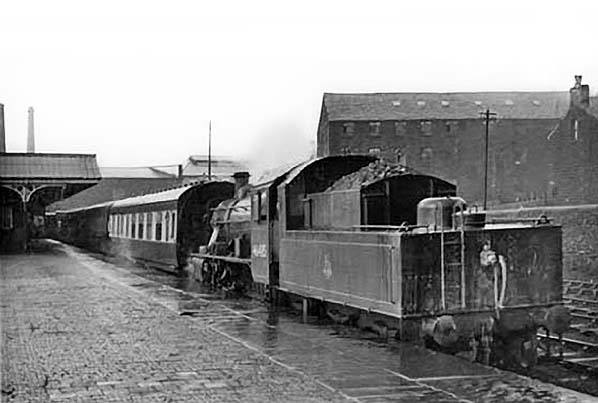
A passenger train at the eastern face of Bacup’s single island platform in May 1952. The Ivatt 2MT 2-6-0 appears to be No.46416, which was one of a handful allocated to Bury shed at the time the photograph was taken. The first carriage is an ex-LMS corridor brake third in BR 'blood and custard' livery.
old17.jpg) Looking north from the south end of Bacup station in April 1954 as a single coach passenger service departs. The service was probably a short working to Ramsbottom.
Copyright photo by R M Casserley old19.jpg) A passenger service is seen departing from Bacup Station in April 1954. Bacup station was still very busy at this time as evidenced by the spare coaches that can be seen waiting in the sidings to the right of the picture. The train would have been for Bury or for Manchester Victoria via Heywood.
Copyright photo by H C Casserley 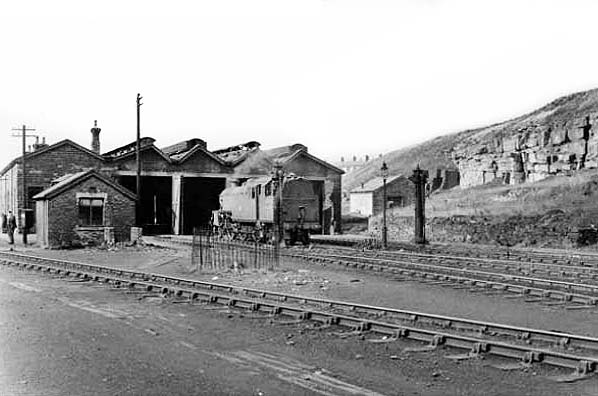 Bacup engine shed looking west in September 1954, the month before it closed. The loco is a Stanier tank, either 2-6-4 or 2-6-2, but its length suggests a 2-6-4T. (None of the Stanier 2-6-2Ts were based in the area at the time of this photograph.) The loco is in the second BR livery – with the ‘Emaciated Ferret’ logo – but the number cannot be read. Click here for Bacup Station Gallery 3:
|


 Home Page
Home Page